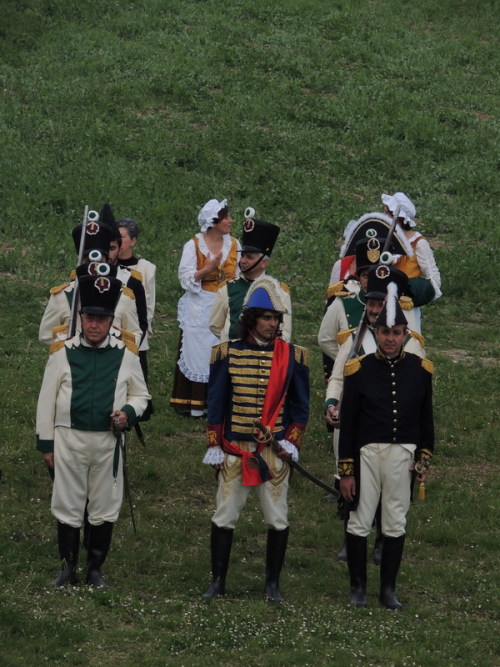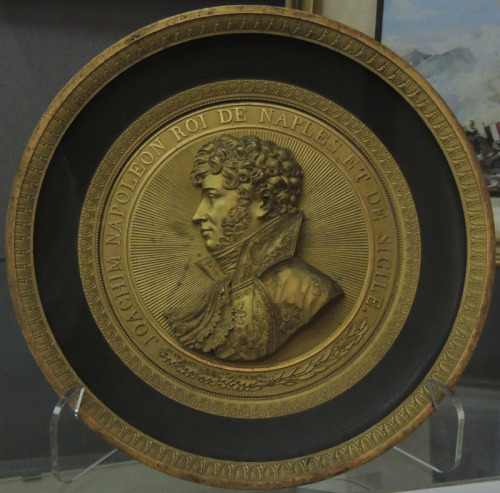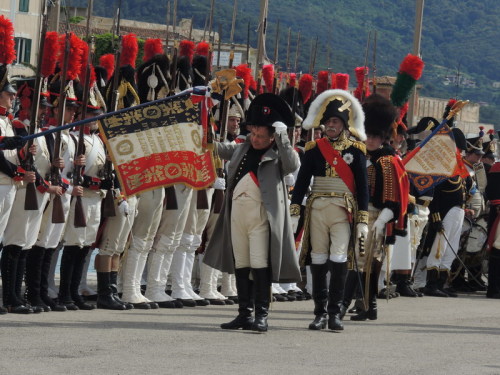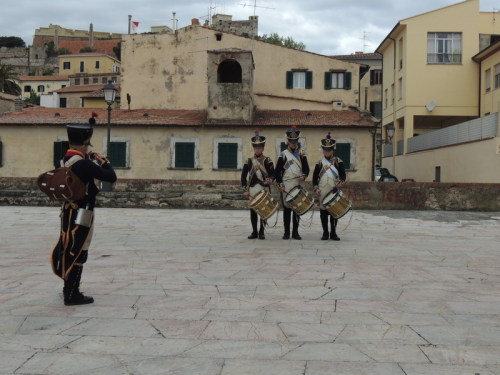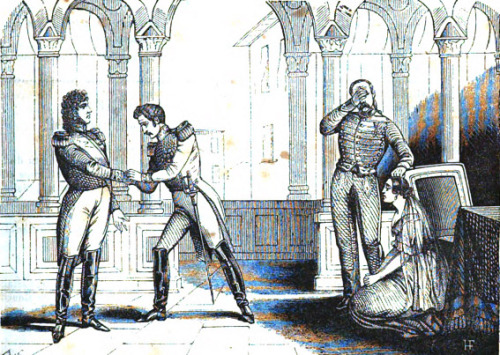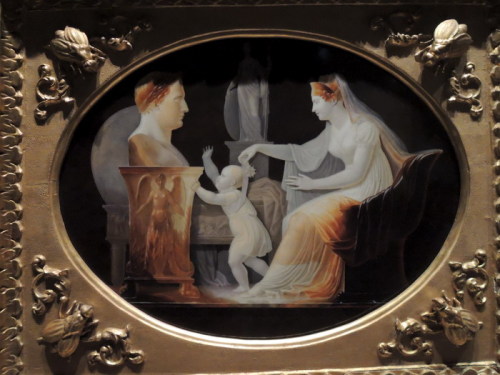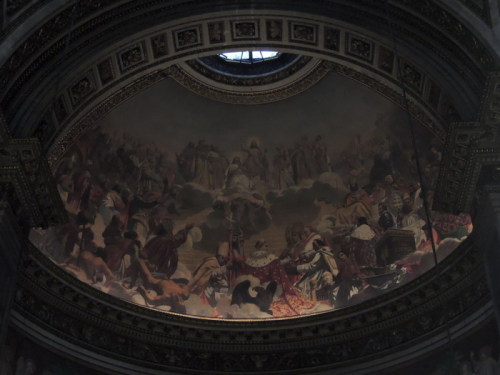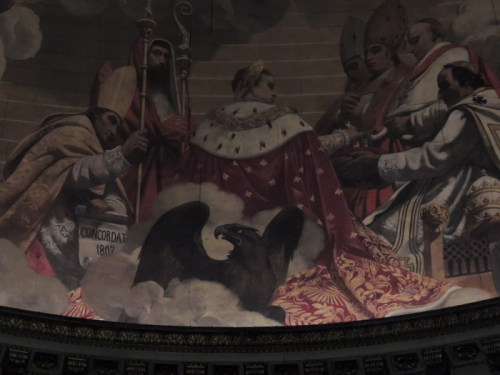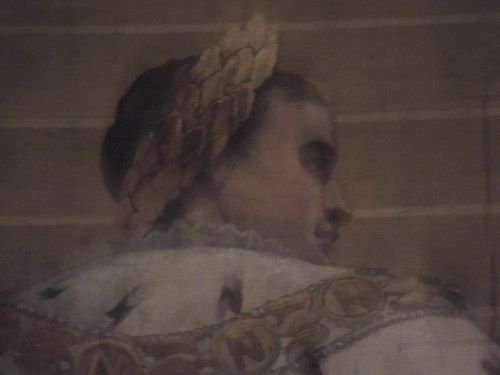#napoleon bonaparte
Original note on the primary blog
Historical background
On January 14-15, 1797, the 28 years old general Bonaparte, commander in chief of the First Republic’s army in Italy, fought a battle with the Austrians that turned out to be one of the decisive episodes of the north Italian campaign, which eventually ended in October of the same year with the diplomatic success that the peace of Campo Formio was. The battlefield comprised the gorges of the neighbouring mountains as well as the plain bordered on the other side by a glacial moraine, and stretched roughly between today’s settlements of Rivoli and Cristane. The Austrian forces, which outnumbered the Army of Italy by some 5 thousand men, were commanded by Jozsef Alvinczi, supported by Franz Lusignan and Heinrich of Reuss-Plauen, while on the French side the chief officers included Louis-Alexandre Berthier, André Masséna, Antoine Lasalle, Barthélemy Joubert and others.

The tiny town of Rivoli Veronese, situated in a picturesque plain over the Adige and at the foothills of Monte Baldo, may be a little off the road, despite its relative vicinity to the very popular Lago di Garda, but the general guidebooks as well as the official website do not do it justice: with its small museum devoted to the 1797 battle it is a place certainly worth a visit for a period fan, even if it means a detour. The museum is private, and if one believed its own advertisements, it might seem that it hosts just a small number of hardly precious items, probably a map of the battlefield and several memorabilia of the kind that can be found anywhere in a thematic museum.

To some extent this is indeed true: many of the engravings may be found in most Napoleonic museums, but Rivoli boasts a truly large collection of relatively rare (even if not unique) pictures and documents, concerning both the battle itself and the Italian campaign, and the period in general. Its collection includes your more or less generic 19th century engravings covering the whole life of the Emperor and a wide range of his generals and family, a large collection of porcelain figurines, day orders and press clippings and several really interesting documents and nice touches such as the listing of headlines in French papers after the escape from Elba. The battle itself is documented by 3D models of the terrain and of the distribution of troops, paintings and drawings, but also by finds excavated in the area: flints and bullets, guns, epaulettes and regiment signs (note a fine collection of Austrian items).

The period is also represented by small precious items among which the small collection of porcelain with portraits draws attention, as well as a number of medals. Among the most interesting objects is the actual travel bed of Marie-Louise (dated on the label to ca. 1800 which seems a quite liberal chronology). The curios include a small fragment of the golden mantle from the Sacre on one hand and sample of soil from Grotte Napoleone in Ajaccio, sent with an official letter by the Musée Fesch. on the other hand.

The main museum is located on the first floor of a small building and consists of one large room divided into sections, where the core of the collection, including battlefield finds is kept, as well as a smaller antechamber (numerous portraits of people involved in Napoleonic wars) and a library, where one wall is covered in shelves lined with impressive collection of topic-related books, while the other walls feature a number of interesting drawings and engravings, and the central showcase presents a collection of documents, partly related to the creation of the museum. On the ground floor a small room hosts a collection of copies of documents related to the Cisalpine Republic. The Napoleonic collection upstairs is also complemented by a small number of memorabilia from the Italian Risorgimento. The only downside of the museum is that not all the items are properly labelled (some are not labelled at all). In some cases I was at a loss, like for instance with the following postcard apparently reproducing a painting (which I had not seen before in any book or museum), clearly an allegorical one. Maybe someone can help me solve the puzzle:

It is worth paying attention to the miniature model of the monument erected in on the battlefield (see below), since the original column was destroyed by the Austrians in 1814 (it is also portrayed on one side of the modern monument).

The museum is run by a very nice and helpful man (Italian speaking only, however), who will eagerly open it outside the official opening hours and apparently does not subscribe to the typical Italian (and Greek) tradition of closing the museums and monuments whenever an opportunity presents itself, so one must not worry about a visit even on the holiday of Ferragosto (Aug. 15th, which coincides with the Emperor’s birthday), otherwise truly sacred to the Italians. The enthusiastic attitude is apparently the heritage of the founder of the museum, Luigi Galanti (1897-1989; descendant of Francesco Maria Galanti, who had accompanied Napoleon during his exile in Elba), whose perseverance in collecting memorabilia paid off not only for the man himself (he received the Legion d’Honneur for instance and a number of other commendations) but also for the museum: its collection is being continuously expanded by donations from people all over the world.
Souvenirs include a very nice series of the vintage style postcards, a small booklet on the history of the collection and its founder, posters advertising the re-enactments of the battle. You should not forget to sign the visitor book (don’t worry, you will be reminded to do it), since the museum boasts itself of guests from all over the world.

The museum is located centrally in the town, on the stretch of the main road which is called Piazza Napoleone, close to the parish church, and it is hard to miss, but finding other places of interest in the area can be a challenge, partly due to the fact that no map available shows the proper location of the monument (the one that hangs in the museum is completely inaccurate in placing the monument by the fort, while the very detailed one on the board in the town square places it on the wrong side of the motorway), and the house in Affi where the General Bonaparte held his headquarters is not shown on any map at all.

To find the battlefieldmonument one has to drive on the Strada Provinciale 11 from the museum to the north, past the signs indicating the road to the fort (which is modern but quite picturesque), follow SP11 when it turns right (direction Trento) at a major crossroads in Zuane, and then drive on: after a short series of serpentines going down the sign “monumento napoleonico/solo pedoni” will appear on the right. Access is on foot only and there is little space for leaving the car (no official parking lot), but since hardly anyone stops there I doubt it is ever impossible. Looking down beyond the motorway one can see a small grove of cypresses with a whitish shape in their midst: that is the monument. (Actually only once you have spotted the cypresses it becomes obvious that the monument is where it is).

To reach the spot one has to go down a comfortable gravel path, which once used to be accessible by car, judging by the remaining signs, and pass beneath the motorway. Just after the bridge there is a path to the left, barred from car access, leading up towards a vineyard. The path is again comfortable, even if rougher than the previous one, and goes up gently. Once up, you simply need to follow it to its natural turn between the grapevine rows (no need to pass under their branches, as it may seem at the first glance). This path leads straight to the monument site, which is encircled by the cypresses and features the reconstructed podium of the original obelisk with inscriptions commemorating the fallen, and a slightly battered French flag on a pole. Behind the podium the remains of the destroyed column can be seen. The site gives a nice view on the surrounding area, but if you want to see the moraine that borders the battlefield it is better to stop on the road just outside Rivoli.

TheCà de’Ri, or Napoleon’s headquarters in today’s Affi, can be reached easily from the roundabout on the outskirts of the town: the street named conveniently Cà de’Ri is right off the small roundabout that connects SP29b and SP9 (on the 29b axis, almost in front of a large shopping area). The house is not accessible to the public, but a board informs us of its historical meaning.

To complement the visit in Rivoli one may drop into the only local restaurant, almost in front of the museum. It is called Bonaparte, and neighbours the Napoleon apartment hotel and serves excellent food at surprisingly affordable prices. Even if you choose to dine outside in the garden, do not miss the inside: it is full of quite interesting items, including very fine collection of porcelain figurines and vintage posters featuring Napoleonic generals.

Practical information
Address of the Museum: 14 Piazza Napoleone I, Rivoli Veronese
GPS data for the museum: N 45.57134 E 010.81189
GPS data for the monument: N 45.58098 E 010.82132
GPS data for Cà de’Ri: N 45.55288 E 010.81189
Museum opening hours:
Phone number to arrange a visit outside the opening hours:
Entry: full EUR 2.50, reduced 1.50.
To reach Rivoli by car from the A22 motorway take the Affi exit and continue to Rivoli on SP29b and then SP11 (Rivoli is signalled on the main roundabouts and crossroads from Affi on). If arriving from the Garda on SS450 take the turn in the direction of A22 on the big roundabout and then follow SP29b and SP11 as above. From SP11 turn towards Rivoli on the crossroads (there is a sign for the museum). If arriving from other directions you have to get to SP29b or SP11 and continue past Zuane and turn left to Rivoli when indicated.
Due to some necessary improvements that are not available or user friendly on tumblr I decided to move the blog to a more “bloggery” platform, therefore since the next note (in a few hours time) all will be published here and reblogged on tumblr. There is also a page on Facebook ready but it features just the links to the posts for now.
The change will allow for better communication with readers, and also for easier tagging/searching within the blog itself. It also means that here I will reblog relevant content from other sites.
Edit: since I don’t like the way simple reblogging just makes a frame with link I decided to mirror the site here instead of reblogging. Blogspot is the primary site but everything will be copied on tumblr.
I was pondering where to start, and after some time I realized that the only place I can start is Ajaccio. And since at some point I decided that major sites should receive both overview articles and then detailed descriptions of particular places of interest in separate notes, therefore here it is: a general thematic stroll through Ajaccio.
As the birthplace of Napoleon Bonaparte and vast majority of his siblings (with the exception of the eldest, Joseph, who was born in Corte), Ajaccio celebrates its most famous citizen by a series of museums and monuments as well as by yearly festivals (fireworks, parades, but also lectures etc.; I missed it this year but hope to be there next year) around August 15th. The city is generally overflowed with the Bonapartes, and the sign at the main entrance (from the east, i.e. from all major roads) informs us that we are in the Imperial City (similar decorations include the imperial crown in Avenue du Premier Consul/Cours Napoléon and the Legion d'Honneur in Cours Grandval).
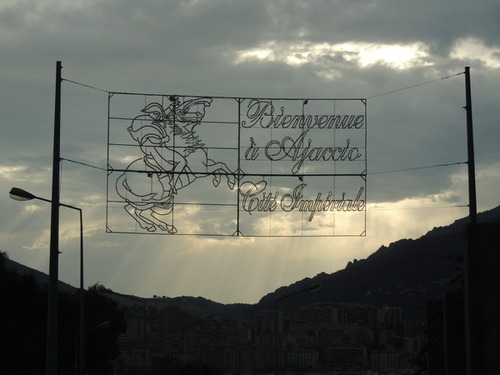
Must-see places include three museums: the Maison Bonaparte (rue Saint-Charles 1), the two rooms in the Musée Fesch (rue Cardinal Fesch 50-52), and the Salon Napoléonien in the city Townhall (Hôtel de Ville; Place Foch), and three monuments: Napoleon as First Consul in Place Foch, Napoleon on the horseback in the company of his four brothers (Place de Gaulle) and the Casone in Place d'Austerlitz, together with the Grotte Napoléon.
Additional traits in the city centre include the period room in the small museum A Bandera (Corsican history), the cathedral of Notre Dame (rue Forcioli Conti) where Napoleon was baptised, the church of Saint Jean Baptiste (rue Roi de Rome/rue Saint-Charles) where other members of the family were baptised, and the building at rue Fesch 28, where a board inform us of the short stay of Napoleon during his escape from Corsica in May 1793.
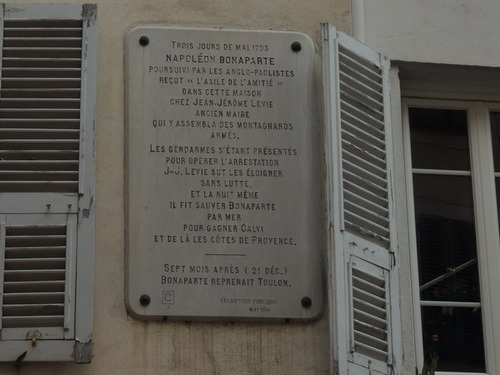
Hardcore fans may also try to collect the whole range of street signs related to both the 1st and 2nd Empire (battlefields are concentrated in the residential area in the western part of the city, close to Place d'Austerlitz, other streets, boulevards, avenues etc. are situated in various parts of the city; note that some people appear twice, for instance there is rue Letizia and boulevard Madame Mère, so don’t strike someone out just because you spotted them once).
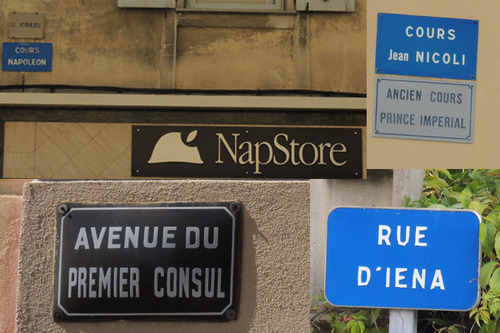
Names of numerous bars, restaurants, cafes and ice-cream lounges also relate to the characters of the period, while some of them make other use of the city’s main attraction (food at affordable prices is really good here, so it can be recommended):
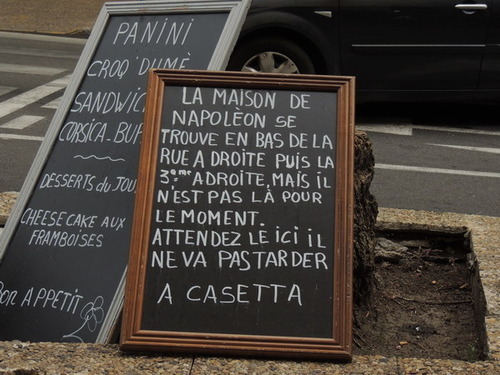
For the atmosphere and numerous prints on the walls, as well for good quality food, the Grand Cafe Napoléon is a culinary must: the pictures cover most of the period’s history, and the large dining room is predictably decorated with the copy of the famous Passage of St. Bernard by David.
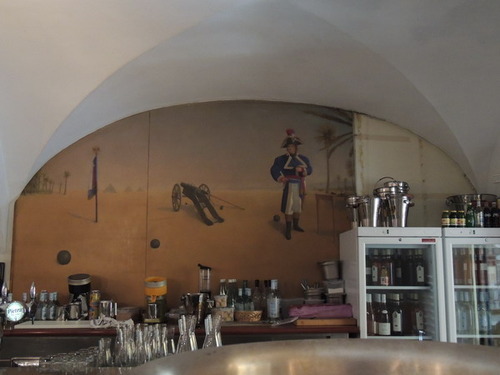
Away from the centre is Les Milleli - the favourite house of Napoleon during his military service in Corsica. Also the Napoléon Bonaparte airport is some way from the city centre to the east, on the seaside. Signs leading to it abound in the city and on its outskirts. Outside Ajaccio, on the way towards the Îles Sanguinaires, on the left hand side of the road westward, are curious remains of either a demolished or an unfinished structure, among which one features undoubtedly the well known silhouette:
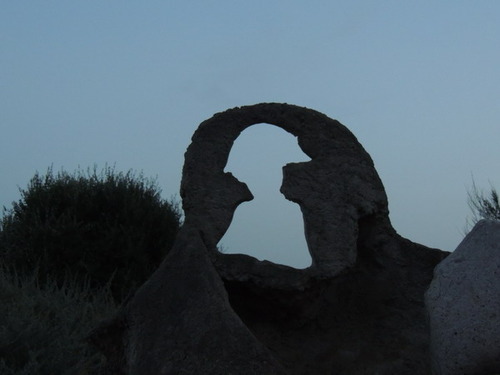
The shops, of course, team with souvenirs, but most of them are kitsch and cheap; however, two boutiques for better value objects are located close to the Maison Bonaparte (Boutique Napoléon just a few steps away from the entrance to the museum; Empires in rue Roi de Rome - the latter’s commodities can also be purchased in museum shops and in the Office de Tourisme d'Ajaccio shop, Boulevard Roi Jérôme 3).
The library in Place Foch has a large selection of books on Corsican history and Napoleonic period on the ground floor.
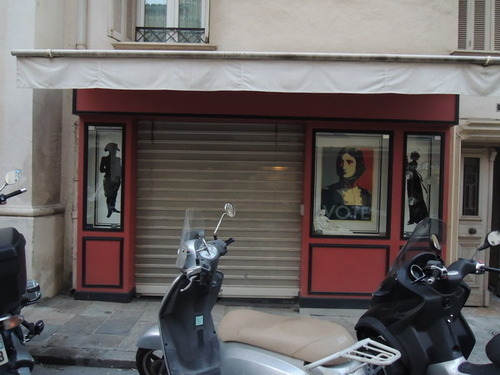
Places related to the period include the birthplace of Carlo Andrea, count of Pozzo di Borgo, once friend and later oponent of Napoleon in the matters of Corsican independence (rue Bonaparte; now converted to the Palazzu u Domu hotel), and several monuments/boards commemorating Pasquale Paoli (e.g. the monument in Bd. Danielle Casanova, by the walls of the Citadel).
Other places of interest include the Genovese trail, of which the Citadel is part (look out for donkeys and goats climbing the walls in the now dry moat), and the Quartier des Étrangers, which is partly connected with the development of the city under the II Empire.
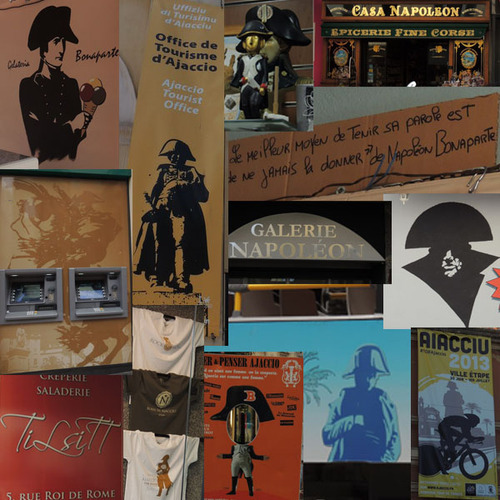
PRACTICAL INFORMATION
Ajaccio, which is the capital of the A1 department (Corse-de-Sud) and hosts the prefecture for the whole island, is situated in central Corsica, in a large bay on the western coast. It has its own airport and ferry port, and can also be easily reached from the main port and second airport in Bastia (ca. 150 km on the direct N 193, below 3 hours of comfortable drive, unless you stop every several miles for breathtaking views and charming little villages).
It is a seaside city with fine climate: the summer heat is balanced by the sea breeze most of the time. The city offers wonderful beach with stunning views. It preserves the atmosphere of the previous turn of centuries in many respects, and (fortunately) is nothing like the modern beach towns of continental Europe.
The historical centre and most of the attractions listed here can be easily reached on foot from most of the in-town hotels, but there are also buses running from the major nearby attractions, where many hotels are located. It is not advisable to try to find parking space in the centre: it is hard to find and expensive, while leaving your car outside the payment zone means that you have to walk some 5-10 minutes through seaside boulevards. To reach Les Milleli it is better to have a car, although seasoned walkers should not have any problems in getting there (no public transportation, though).
Most restaurants close between 2 and 3 p.m. for a long break until 7 p.m., so it is only possible to eat something substantial in selected cafes and fast foods in that time. Most museums also have breaks during the day (and unpredictable free days, too), so it is better to check opening times while planning the visit.
I was pondering where to start, and after some time I realized that the only place I can start is Ajaccio. And since at some point I decided that major sites should receive both overview articles and then detailed descriptions of particular places of interest in separate notes, therefore here it is: a general thematic stroll through Ajaccio.
As the birthplace of Napoleon Bonaparte and vast majority of his siblings (with the exception of the eldest, Joseph, who was born in Corte), Ajaccio celebrates its most famous citizen by a series of museums and monuments as well as by yearly festivals (fireworks, parades, but also lectures etc.; I missed it this year but hope to be there next year) around August 15th. The city is generally overflowed with the Bonapartes, and the sign at the main entrance (from the east, i.e. from all major roads) informs us that we are in the Imperial City (similar decorations include the imperial crown in Avenue du Premier Consul/Cours Napoléon and the Legion d'Honneur in Cours Grandval).

Must-see places include three museums: the Maison Bonaparte (rue Saint-Charles 1), the two rooms in the Musée Fesch (rue Cardinal Fesch 50-52), and the Salon Napoléonien in the city Townhall (Hôtel de Ville; Place Foch), and three monuments: Napoleon as First Consul in Place Foch, Napoleon on the horseback in the company of his four brothers (Place de Gaulle) and the Casone in Place d'Austerlitz, together with the Grotte Napoléon.
Additional traits in the city centre include the period room in the small museum A Bandera (Corsican history), the cathedral of Notre Dame (rue Forcioli Conti) where Napoleon was baptised, the church of Saint Jean Baptiste (rue Roi de Rome/rue Saint-Charles) where other members of the family were baptised, and the building at rue Fesch 28, where a board inform us of the short stay of Napoleon during his escape from Corsica in May 1793.

Hardcore fans may also try to collect the whole range of street signs related to both the 1st and 2nd Empire (battlefields are concentrated in the residential area in the western part of the city, close to Place d'Austerlitz, other streets, boulevards, avenues etc. are situated in various parts of the city; note that some people appear twice, for instance there is rue Letizia and boulevard Madame Mère, so don’t strike someone out just because you spotted them once).

Names of numerous bars, restaurants, cafes and ice-cream lounges also relate to the characters of the period, while some of them make other use of the city’s main attraction (food at affordable prices is really good here, so it can be recommended):

For the atmosphere and numerous prints on the walls, as well for good quality food, the Grand Cafe Napoléon is a culinary must: the pictures cover most of the period’s history, and the large dining room is predictably decorated with the copy of the famous Passage of St. Bernard by David.

Away from the centre is Les Milleli - the favourite house of Napoleon during his military service in Corsica. Also the Napoléon Bonaparte airport is some way from the city centre to the east, on the seaside. Signs leading to it abound in the city and on its outskirts. Outside Ajaccio, on the way towards the Îles Sanguinaires, on the left hand side of the road westward, are curious remains of either a demolished or an unfinished structure, among which one features undoubtedly the well known silhouette:

The shops, of course, team with souvenirs, but most of them are kitsch and cheap; however, two boutiques for better value objects are located close to the Maison Bonaparte (Boutique Napoléon just a few steps away from the entrance to the museum; Empires in rue Roi de Rome - the latter’s commodities can also be purchased in museum shops and in the Office de Tourisme d'Ajaccio shop, Boulevard Roi Jérôme 3).
The library in Place Foch has a large selection of books on Corsican history and Napoleonic period on the ground floor.

Places related to the period include the birthplace of Carlo Andrea, count of Pozzo di Borgo, once friend and later oponent of Napoleon in the matters of Corsican independence (rue Bonaparte; now converted to the Palazzu u Domu hotel), and several monuments/boards commemorating Pasquale Paoli (e.g. the monument in Bd. Danielle Casanova, by the walls of the Citadel).
Other places of interest include the Genovese trail, of which the Citadel is part (look out for donkeys and goats climbing the walls in the now dry moat), and the Quartier des Étrangers, which is partly connected with the development of the city under the II Empire.

PRACTICAL INFORMATION
Ajaccio, which is the capital of the A1 department (Corse-de-Sud) and hosts the prefecture for the whole island, is situated in central Corsica, in a large bay on the western coast. It has its own airport and ferry port, and can also be easily reached from the main port and second airport in Bastia (ca. 150 km on the direct N 193, below 3 hours of comfortable drive, unless you stop every several miles for breathtaking views and charming little villages).
It is a seaside city with fine climate: the summer heat is balanced by the sea breeze most of the time. The city offers wonderful beach with stunning views. It preserves the atmosphere of the previous turn of centuries in many respects, and (fortunately) is nothing like the modern beach towns of continental Europe.
The historical centre and most of the attractions listed here can be easily reached on foot from most of the in-town hotels, but there are also buses running from the major nearby attractions, where many hotels are located. It is not advisable to try to find parking space in the centre: it is hard to find and expensive, while leaving your car outside the payment zone means that you have to walk some 5-10 minutes through seaside boulevards. To reach Les Milleli it is better to have a car, although seasoned walkers should not have any problems in getting there (no public transportation, though).
Most restaurants close between 2 and 3 p.m. for a long break until 7 p.m., so it is only possible to eat something substantial in selected cafes and fast foods in that time. Most museums also have breaks during the day (and unpredictable free days, too), so it is better to check opening times while planning the visit.
I travel extensively around Europe - usually visiting Classical, i.e. Greek and Roman, sites and museums (well, I’m a Classical archaeologist and I mostly travel with my Classicist friend) but recently, due to my growing interest in modern history, and the turn of the 18th and 19th century in particular, I decided to make a possibly detailed tour of Napoleonic places in Europe and I was surprised that there was no thematic guidebook that could help me in planning itineraries (while I bought without problems for instance Roman France, archaeological guide to Greece, or Arthurian Britain). Therefore I keep gleaning data from the internet, period fora, general guidebooks and local information centres, I also take extensive notes and numerous photos when I go places, and I decided it may be nice to share it with other people interested in the period. I would love to compile one day a book from what I gather and learn myself.
As, however, this is a blog and not a book, it will be organized by tags and not chapters; I may also include some additional period or context info from time to time. The blog form also allows me to be open about not liking certain characters, so don’t expect me to write well about Josephine for instance, even though of course I feel obliged to include information about places and memorabilia related to her.
Since I would like this blog to provide help to other travellers, I will do my best to provide as much practical information (how to get there, GPS data, etc.) as possible, especially in case of places and curiosities off the beaten track.
This year saw my first trips on this new route, but I managed to cover a nice number of interesting places in Corsica, Elba, Northern Italy, Austria, the Czech Republic as well as in London, and in a month’s time I’m going to Paris, so there is already much to write about, and I’m also researching the opportunities given by my native Poland.

Gioacchino Murat at the reconstruction of his last battle - Tolentino 1815 at the Castello della Rancia, Italy.
133 photos in the album here: https://plus.google.com/u/0/photos/109967015083281037398/albums/6149243678006087585
Post link
Unusual early 19th century medals with the portraits of Joachim and Caroline Murat as the king and queen of Naples.
Bologna, Museo Civico del Risorgimento
(photos by myself)
Post link
Arthur Honnegger’s (acts II, III, IV) and Jacques Ibert’s (acts I, V) opera about Napoleon II, libretto after Rostand’s L'Aiglon, premiered in 1937. Great music, heart-rendering story, and definitely too rarely staged or recorded. I have been listening to the audio recording of this particular performance for two days now and I’d love to see it on stage.
Arthur Honnegger’s (acts II, III, IV) and Jacques Ibert’s (acts I, V) opera about Napoleon II, libretto after Rostand’s L'Aiglon, premiered in 1937. Great music, heart-rendering story, and definitely too rarely staged or recorded. I have been listening to the audio recording of this particular performance for two days now and I’d love to see it on stage.
Original post: “Franςois Napoléon” on Blogspot
Ajaccio, monument to the Roi de Rome
Today is the 203 birthday of Napoléon François Charles Joseph Bonaparte, at his birth given the title of the King of Rome, but for most of his short life, since 1818, known as the Duke of Reichstadt. The only son of Napoleon and Marie-Louise Habsburg, and the Emperor’s only legitimate child, he lived three happy years in France, adored by his father (he later claimed he remembered that period), but in 1814 he left France and never saw it again, even though formally he had been the emperor Napoleon II for a short time.
A. Menjaud, 1812 (Fontainebleau)
His birth was announced by 101 cannon fires but he lived most of his life in what effectually was a prison, or a golden cage. By the decision of the Congress of Vienna he remained with his Austrian family, while the French one was kept away from him: he never met any of his numerous uncles, aunts or cousins, because the European powers feared that he could threaten the reactionist peace that had been achieved by the Congress.
He left Schoenbrunn only on a small number of occassions, never on his own, and ravelled as far as Pressburg (today’s Bratislava, ca. 70 km from Vienna) and Graz (hardly 200 km from Vienna), even though he dreamed of visiting Italy, where his mother lived in her Duchy of Parma, estranged from both her exiled husband and her unhappy son.
Fontainebleau
He received thorough education, even though the main objective of his teachers was to eradicate the French part of his heritage, and despite the fact that for most of his life he refused to learn - to spite the Austrians. He became an avid reader and student once eventually at the age of 20 he was pronounced adult. He neglected his fragile health, and nobody cared enough to look for the true reasons for its deterioration.
He died aged 21, lonely in a room full of people, and judging by the documents, convinced that his life had been worthless. And yet all the documents that we possess, which are not numerous and a weird selection (many apparently had been destroyed after his death), give testimony to the phrase that was allegedly coined by one of his doctors: “a soul of iron in a body of crystal”.
Had he been allowed to ascend the throne, history of 19th century Europe would have for certain been different. But there was no place for his revolutionary brilliant mind in the Europe lulled into conservatism by the Holy Alliance. Gossip that he was poisoned has not died until now.
Edmond Rostand’s drama L'Aiglon, focused on the last years of his life,is one of the masterpieces of French literature of the turn of the 19th/20th centuries, and the famous Sarah Bernhardt starred in its premiere in the lead role, which became one of the hallmarks of her career.
A small number of places in France and Austria are witnesses to his short and sad life. In Vienna one can see his famous cradle designed by Pierre-Paul Prud'hon, kept now in the Kaiserliche Schatzkammer.
Kaiserliche Schatzkammer
Only some eight underground stations away from there, in the Schoenbrunn palace, the longer route takes the visitors to the room where he died (and where, by the irony of fates, his father lived in 1809, after the capture of Vienna). Among the morbid memorabilia in Schoenbrunn is the stuffed favourite pet bird of the prince.
A lovely selection of items from his happy years in France, and also some memorabilia from the later years can be seen in the Napoleonic museum in the palace of Fontainebleau; in the palace of Compiègne one can see a room where he used to live and a beautiful Egyptian revival clock that belonged to him; also in the Musée Carnavalet in Paris a couple of objects can be found.
The Louvre possesses a beautiful painting of the little King of Rome, and in Ajaccio in Corsica his only monument stand in front of the hourse where his father had been born.
He was originally buried partly in the Capucin crypt in Vienna, with all the Habsburgs, and partly in the cathedral in Vienna, but his remains were brought to Paris in 1940, and now they repose in the Dome des Invalides, in a side crypt of the main chapel with his father’s sarcophagus.
Les Invalides
Original post: “Franςois Napoléon” on Blogspot
Ajaccio, monument to the Roi de Rome
Today is the 203 birthday of Napoléon François Charles Joseph Bonaparte, at his birth given the title of the King of Rome, but for most of his short life, since 1818, known as the Duke of Reichstadt. The only son of Napoleon and Marie-Louise Habsburg, and the Emperor’s only legitimate child, he lived three happy years in France, adored by his father (he later claimed he remembered that period), but in 1814 he left France and never saw it again, even though formally he had been the emperor Napoleon II for a short time.
A. Menjaud, 1812 (Fontainebleau)
His birth was announced by 101 cannon fires but he lived most of his life in what effectually was a prison, or a golden cage. By the decision of the Congress of Vienna he remained with his Austrian family, while the French one was kept away from him: he never met any of his numerous uncles, aunts or cousins, because the European powers feared that he could threaten the reactionist peace that had been achieved by the Congress.
He left Schoenbrunn only on a small number of occassions, never on his own, and ravelled as far as Pressburg (today’s Bratislava, ca. 70 km from Vienna) and Graz (hardly 200 km from Vienna), even though he dreamed of visiting Italy, where his mother lived in her Duchy of Parma, estranged from both her exiled husband and her unhappy son.
Fontainebleau
He received thorough education, even though the main objective of his teachers was to eradicate the French part of his heritage, and despite the fact that for most of his life he refused to learn - to spite the Austrians. He became an avid reader and student once eventually at the age of 20 he was pronounced adult. He neglected his fragile health, and nobody cared enough to look for the true reasons for its deterioration.
He died aged 21, lonely in a room full of people, and judging by the documents, convinced that his life had been worthless. And yet all the documents that we possess, which are not numerous and a weird selection (many apparently had been destroyed after his death), give testimony to the phrase that was allegedly coined by one of his doctors: “a soul of iron in a body of crystal”.
Had he been allowed to ascend the throne, history of 19th century Europe would have for certain been different. But there was no place for his revolutionary brilliant mind in the Europe lulled into conservatism by the Holy Alliance. Gossip that he was poisoned has not died until now.
Edmond Rostand’s drama L'Aiglon, focused on the last years of his life,is one of the masterpieces of French literature of the turn of the 19th/20th centuries, and the famous Sarah Bernhardt starred in its premiere in the lead role, which became one of the hallmarks of her career.
A small number of places in France and Austria are witnesses to his short and sad life. In Vienna one can see his famous cradle designed by Pierre-Paul Prud'hon, kept now in the Kaiserliche Schatzkammer.
Kaiserliche Schatzkammer
Only some eight underground stations away from there, in the Schoenbrunn palace, the longer route takes the visitors to the room where he died (and where, by the irony of fates, his father lived in 1809, after the capture of Vienna). Among the morbid memorabilia in Schoenbrunn is the stuffed favourite pet bird of the prince.
A lovely selection of items from his happy years in France, and also some memorabilia from the later years can be seen in the Napoleonic museum in the palace of Fontainebleau; in the palace of Compiègne one can see a room where he used to live and a beautiful Egyptian revival clock that belonged to him; also in the Musée Carnavalet in Paris a couple of objects can be found.
The Louvre possesses a beautiful painting of the little King of Rome, and in Ajaccio in Corsica his only monument stand in front of the hourse where his father had been born.
He was originally buried partly in the Capucin crypt in Vienna, with all the Habsburgs, and partly in the cathedral in Vienna, but his remains were brought to Paris in 1940, and now they repose in the Dome des Invalides, in a side crypt of the main chapel with his father’s sarcophagus.
Les Invalides
Today is the birthday (203) of Napoléon François Charles Joseph Bonaparte, the King of Rome, better known, unfortunately, as the Duke of Reichstadt. One of the saddest histories ever.
This is a stained glass panel by Alfred Échivard (1866-1939), currently in the Musée de la Légion d'Honneur in Paris.
(Source: my photo)
Post link
Today is the birthday (203) of Napoléon François Charles Joseph Bonaparte, the King of Rome, better known, unfortunately, as the Duke of Reichstadt. One of the saddest histories ever.
This is a stained glass panel by Alfred Échivard (1866-1939), currently in the Musée de la Légion d'Honneur in Paris.
(Source: my photo)
Post link
The first steps of the King of Rome on a cameo. An absolutely goregous item in the collection of the Musée national de la Légion d'honneur et des ordres de chevalerie in Paris.
(source: my photo)
Post link
The first steps of the King of Rome on a cameo. An absolutely goregous item in the collection of the Musée national de la Légion d'honneur et des ordres de chevalerie in Paris.
(source: my photo)
Post link
Church of la Madelaine in Paris. The fresco commemorating the Concordate of 1801, with close-ups of Napoleon.
(source: my photos)
Post link
Church of la Madelaine in Paris. The fresco commemorating the Concordate of 1801, with close-ups of Napoleon.
(source: my photos)
Post link
Warsaw (Plac Powstańców Warszawy), the monument to Napoleon, exact copy of the monument that had been erected here in 1921 (on May 5th), and stolen, and then re-erected in 1923, and later destroyed in WW II, and eventually re-erected again in 2011 (on May 5th), hopefully for good…
The dedication is “To the Great Leader the Military Academy”
Post link

